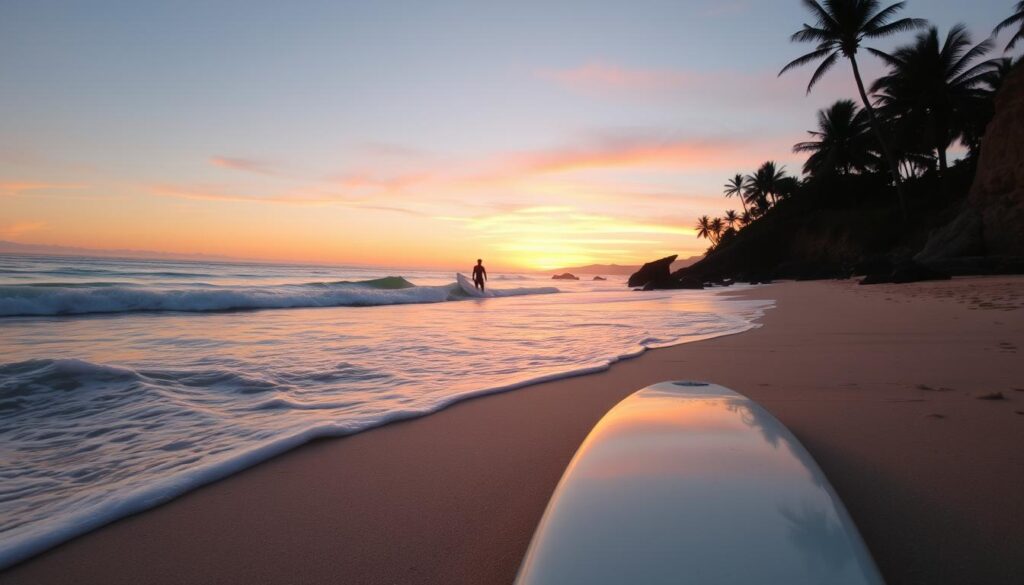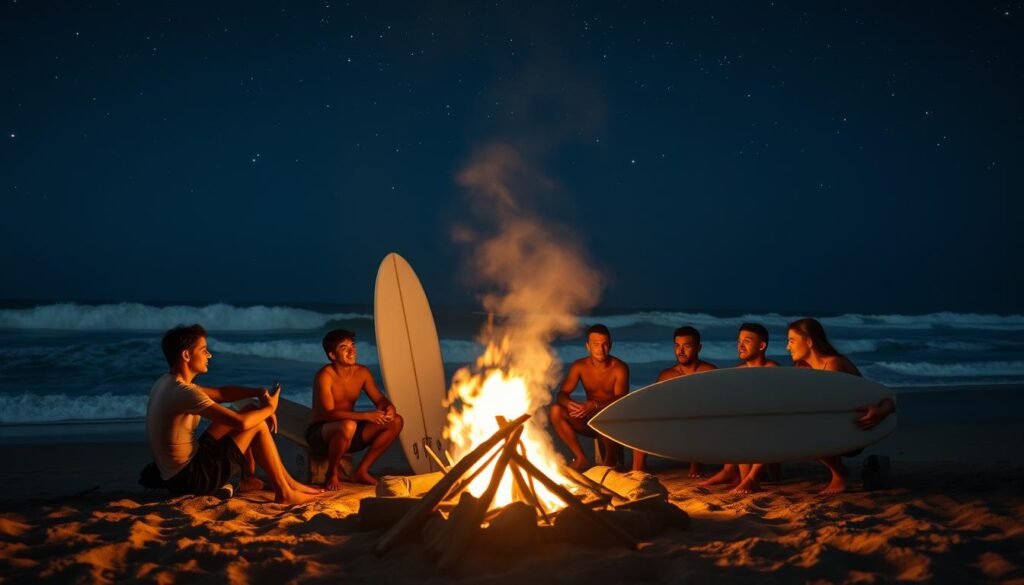Personal Surfer Stories: Moments of Victory and Defeat 5
Table of Contents
Personal Surfer Stories. The ocean calls to every surfer in its way. For some, it’s a whisper of adventure. For others, it’s a roar of challenge. Your first time surfing or Surfing journey is more than just riding waves. Personal Surfer Stories. It’s about finding a deep connection with the sea that changes how you see the world.

Personal Surfer Stories. Kelly Slater, a world champion surfer, said surfing is like life’s rhythm. It’s unpredictable, exciting, and always changing. Stories from surfers show that each wave has its tale of bravery, strength, and happiness.
Whether you’re a beginner or an experienced surfer, Personal Surfer Stories is more than a sport. It’s a way of life that connects us with nature’s power.
Key Takeaways
- Surfing is more than just a fun activity
- Every wave offers a unique challenge and chance
- Personal stories shape a surfer’s journey
- The ocean connection is deeply emotional and life-changing
- Surfing teaches us to be resilient and adaptable
The Magic of First Wave Encounters
Personal Surfer Stories is more than a sport—it’s a journey that changes your view of the world. Your first time in the ocean leaves a lasting memory. It captures the essence of adventure that lasts a lifetime.

Starting to surf means beginning a journey of self-discovery. The waves teach you to push past your limits with every paddle and ride.
Finding Your Balance: Early Morning Surf Sessions
Early morning surf sessions are special. They offer a moment of peace and possibility. As the sun rises, you’ll learn to:
- Read ocean rhythms
- Understand wave patterns
- Develop core strength
- Connect with nature’s raw energy
“The ocean speaks a language of patience and persistence. Listen carefully, and it will teach you everything.” – Professional Surfer Kelly Slater
Memorable Wipeouts and Learning Curves
Every wipeout is a lesson. Your journey isn’t about perfect rides. It’s about the strength you build from falling and getting back up. Surfing teaches you to be tough mentally and adaptable.
Building Confidence in the Lineup
Getting into the surfing community takes courage and respect. You’ll learn the unspoken rules, develop awareness of your space, and earn your spot among others.
- Observe experienced surfers
- Respect wave priority
- Practice communication
- Stay humble and patient
Personal Stories from Surfers About Their Experiences

Personal Surfer Stories is more than a sport; it’s a journey of self-discovery. Pro surfer biographies show how riders change when they connect with the ocean’s power.
Every surfing Personal Surfer Stories is unique and filled with challenges, victories, and magical moments. Surfers from all walks of life talk about how surfing has changed their lives:
- Kelly Slater overcame small-town limitations through his passion
- Bethany Hamilton turned personal tragedy into a source of inspiration
- Laird Hamilton pioneered big wave surfing with new techniques
“The ocean doesn’t care about your background—it tests your spirit and rewards your courage.” – Professional Surfer Maya Gabeira
Personal Surfer Stories show how surfing can change lives. Whether it’s your first wave or competing globally, every moment is meaningful.
Surf communities around the world are connected. They know success isn’t just about the waves. It’s about personal growth, respect for nature, and the amazing stories they share.
Behind every wave lies a story of courage, resilience, and human potential.
Chasing Swells Around the World
Surf trip journals are more than just travel logs. They are passports to extraordinary ocean adventures. Surfers worldwide go on epic journeys, seeking the perfect wave and finding hidden gems across continents.
Personal Surfer Stories show the true spirit of surf exploration. These global quests take passionate riders through diverse landscapes. They connect them with unique coastal cultures and remarkable wave experiences.
Hidden Surf Spots and Local Legends
Every surf destination has its mystique. Remote beaches and tucked-away breaks offer experiences beyond typical tourist routes. Local surf legends often guard these secret locations, sharing Personal Surfer Stories that make simple surf spots seem mythical.
- Undiscovered breaks in remote Indonesian islands
- Secluded wave points along the Chilean coastline
- Unexpected surf havens in unexpected geographical regions
Cultural Connections Through Surfing
Surfing breaks down language barriers, creating deep connections between people from different backgrounds. The ocean becomes a universal language, where respect and shared passion unite surfers across global communities.
“Surfing is the most global conversation without words.” – Unknown Surf Philosopher
Weather Challenges and Ocean Wisdom
Navigating unpredictable oceanic conditions demands skill, patience, and deep respect for nature. Experienced surfers know that reading weather patterns and understanding ocean dynamics are key survival skills.
- Interpreting wind directions
- Understanding tide movements
- Recognizing potential marine hazards
Conclusion
Your surfing adventure is more than just riding waves. It’s about a lifestyle that changes you. Each wave is a symbol of growth, challenge, and connecting with nature’s power.
Surfing Personal Surfer Stories from all over show it’s more than just a sport. Whether you’re starting in California or tackling big waves in Hawaii, it’s about facing the unknown. It teaches us to find balance in life.
The ocean teaches us to be strong, patient, and respectful. Surfing connects you with a worldwide community of water lovers. You learn to read waves and understand surf cultures, shaping your view of the world.
Every wave has a Personal Surfer Story to tell. Your bond with the ocean is special and keeps growing. Keep facing challenges, celebrate wins, and always paddle forward with courage and a sense of adventure.
FAQ
How do I get started with surfing as a beginner?
Start by taking lessons from a qualified surf instructor. They will teach you the basics, ocean safety, and how to handle the board. Begin with smaller waves and use a longer, more stable surfboard.
Practice consistently. Many surf schools offer beginner classes. They provide equipment and guidance to help you build confidence in the water.
What equipment do I need as a new surfer?
You’ll need a surfboard, a wetsuit (if the water is cold), surf wax, a leash, and reef-safe sunscreen. For beginners, a longer, wider board is best for stability. Renting equipment is a good way to try different boards before buying.
How long does it typically take to learn how to surf?
It takes about 10-15 hours of practice to catch small waves and have basic skills. Lessons and time in the water are key. Some learn faster, while others take months to feel comfortable.
Be patient and persistent. Your surfing journey is unique.
What are the most important safety considerations for surfing?
Understanding ocean conditions and knowing how to read waves and currents are crucial. Learn proper paddling techniques and be aware of your surroundings. Always surf within your skill level and use a leash.
Be mindful of other surfers and learn basic ocean rescue techniques. Check local conditions and weather forecasts before heading out.
How do I choose the right surfboard for my skill level?
Beginners should choose a longer, wider board for stability and easier paddling. Soft-top boards are great for learning. As you progress, you can move to shorter, more maneuverable boards.
Consider your height, weight, fitness level, and the waves you’ll surf when selecting a board.
What physical fitness is recommended for surfing?
Surfing needs core strength, upper body endurance, and cardiovascular fitness. Include swimming, paddling, yoga, and strength training in your routine. Focus on exercises that improve balance, shoulder strength, and flexibility.
Swimming is especially good for building the muscles used in surfing.
How expensive is it to get into surfing?
Initial costs vary. Budget $500-$1,500 for beginner equipment. Lessons can cost $50-$100 per session. Many start by renting equipment and taking lessons to save money.
As you progress, you might buy your gear and travel to different surf spots.
What are the best locations for beginner surfers?
Great spots for beginners include Waikiki in Hawaii, Costa Rica’s beach breaks, Byron Bay in Australia, and California’s Santa Cruz. Look for places with gentle waves, sandy bottoms, and surf schools nearby.
These destinations offer manageable waves, supportive surf communities, and excellent learning environments.

